Stability Analysis of Jinchuan Hydropower Station Hydraulic Tunnels during Excavation and Unloading
Abstract
1. Introduction
2. Engineering Background
3. Study of the MS Activity of the Surrounding Rock
3.1. Temporal Evolution Characteristics of MS Events
3.2. Spatial Evolution Characteristics of MS Events
4. Numerical Modeling of the Excavation of Adjacent Tunnels
4.1. FLAC3D Finite-Difference Software
4.2. Modeling
4.3. Constitutive Model and Parameters
4.4. Mechanical Response of the Surrounding Rock during Step-by-Step Excavation
4.4.1. Deformation Characteristics of the Surrounding Rock
4.4.2. Stress Characteristics of the Surrounding Rock
4.5. Comparison between Numerical Modeling and Monitoring Results
4.6. Comparison between Numerical Modeling and Site Surveys
5. Conclusions
- (1)
- The study focused on the temporal and spatial evolution characteristics of MS events brought on by the excavation and unloading of the spillway tunnel. When the causes of MS event concentration under various working conditions were combined with the site construction conditions, it was determined that the main causes of MS events were construction disturbance and an unfavorable geological structure, which damaged the surrounding rock and made it vulnerable to macroscopic deformation.
- (2)
- In the tunnel at shallow burial depths, there was only a slight stress concentration at some right-angle intersections of the free face due to the low level of ground stress, and the minimum principal stress of the shallow surrounding rock was directed at the free face, while the direction of the maximum principal stress was parallel to that of the tunnel axis, thus helping ensure tunnel stability. In the deeper part of the tunnel, the stress concentration became obvious due to the increased level of ground stress, and the maximum principal stress was nearly perpendicular to the tunnel axis, thus undermining the stability of the tunnel surrounding rock.
- (3)
- By comparing microseismic monitoring results, numerical simulation, and conventional monitoring, it is found that there is a good spatial correspondence between microseismic monitoring and numerical simulation results, as well as good temporal correspondence between numerical simulation results and changes in stress gauges, which proves the feasibility of the comprehensive research method of microseismic monitoring combined with numerical simulation. It can provide reliable technical support for assessing the stability of the surrounding rock.
Author Contributions
Funding
Institutional Review Board Statement
Informed Consent Statement
Data Availability Statement
Conflicts of Interest
References
- Li, B.; Xu, N.W.; Dai, F.; Gu, G.K.; Ke, W. Microseismic monitoring and stability analysis for the large-scale underground caverns at the Wudongde hydropower station. Bull. Eng. Geol. Environ. 2020, 79, 3559–3573. [Google Scholar] [CrossRef]
- Sun, Y.P.; Li, B.; Dong, L.L.; Mao, H.Y.; Xu, N.W.; Zhu, Z.P.; Liu, J.F. Microseismic moment tensor based analysis of rock mass failure mechanism surrounding an underground powerhouse. Geomat. Nat. Haz. Risk 2021, 12, 1315–1342. [Google Scholar] [CrossRef]
- Liang, Z.Z.; Xue, R.X.; Xu, N.W.; Dong, L.; Zhang, Y. Analysis on microseismic characteristics and stability of the access tunnel in the main powerhouse, Shuangjiangkou hydropower station, under high in situ stress. Bull. Eng. Geol. Environ. 2020, 79, 3231–3244. [Google Scholar] [CrossRef]
- Li, B.; Ding, Q.F.; Xu, N.W.; Dai, F.; Xu, Y.; Qu, H.L. Characteristics of microseismic b-value associated with rock mass large deformation in underground powerhouse caverns at different stress levels. J. Cent. South Univ. 2022, 29, 693–711. [Google Scholar] [CrossRef]
- Li, A.; Dai, F.; Liu, Y.; Liu, K.; Wang, K. Deformation characteristics of sidewall and anchorage mechanisms of prestressed cables in layered rock strata dipping steeply into the inner space of underground powerhouse cavern. Int. J. Rock Mech. Min. Sci. 2022, 159, 105234. [Google Scholar] [CrossRef]
- Wan, Y.G. Contemporary tectonic stress field in China. Earthq. Sci. 2010, 23, 377–386. [Google Scholar] [CrossRef]
- Young, R.P.; Collins, D.S.; Reyes-Montes, J.M.; Baker, C. Quantification and interpretation of seismicity. Int. J. Rock Mech. Min. Sci. 2004, 41, 1317–1327. [Google Scholar] [CrossRef]
- Trifu, C.I.; Shumila, V. Microseismic monitoring of a controlled collapse in Field II at Ocnele Mari, Romania. Pure Appl. Geophys. 2010, 167, 27–42. [Google Scholar] [CrossRef]
- Leśniak, A.; Isakow, Z. Space–time clustering of seismic events and hazard assessment in the Zabrze-Bielszowice coal mine, Poland. Int. J. Rock Mech. Min. Sci. 2009, 46, 918–928. [Google Scholar] [CrossRef]
- Hudyma, M.; Potvin, Y.H. An engineering approach to seismic risk management in hardrock mines. Rock Mech. Rock Eng. 2010, 43, 891–906. [Google Scholar] [CrossRef]
- Denlinger, R.P.; Bufe, C.G. Reservoir conditions related to induced seismicity at the Geysers steam reservoir, northern California. Bull. Seismol. Soc. Am. 1982, 72, 1317–1327. [Google Scholar] [CrossRef]
- Rutledge, J.T.; Phillips, W.S. Hydraulic stimulation of natural fractures as revealed by induced microearthquakes, Carthage Cotton Valley gas field, east Texas. Geophysics 2003, 68, 441–452. [Google Scholar] [CrossRef]
- Majer, E.L.; McEvilly, T.V. Seismological investigations at The Geysers geothermal field. Geophysics 1979, 44, 246–269. [Google Scholar] [CrossRef]
- Xu, N.W.; Tang, C.A.; Li, L.C.; Zhou, Z.; Sha, C.; Liang, Z.Z.; Yang, J.Y. Microseismic monitoring and stability analysis of the left bank slope in Jinping first stage hydropower station in southwestern China. Int. J. Rock Mech. Min. Sci. 2011, 48, 950–963. [Google Scholar] [CrossRef]
- Xu, N.W.; Tang, C.A.; Li, H.; Dai, F. Excavation-induced microseismicity: Microseismic monitoring and numerical simulation. J. Zhejiang Univ. Sci. A 2012, 13, 445–460. [Google Scholar] [CrossRef]
- Xu, N.W.; Dai, F.; Liang, Z.Z.; Zhou, Z.; Sha, C.; Tang, C.A. The dynamic evaluation of rock slope stability considering the effects of microseismic damage. Rock Mech. Rock Eng. 2014, 47, 621–642. [Google Scholar] [CrossRef]
- Li, B.; Li, T.; Xu, N.; Dai, F.; Chen, W.; Tan, Y. Stability assessment of the left bank slope of the Baihetan Hydropower Station, Southwest China. Int. J. Rock Mech. Min. Sci. 2018, 104, 34–44. [Google Scholar] [CrossRef]
- Li, B.; Xu, N.; Dai, F.; Zhang, G.; Xiao, P. Dynamic analysis of rock mass deformation in large underground caverns considering microseismic data. Int. J. Rock Mech. Min. Sci. 2019, 122, 104078. [Google Scholar] [CrossRef]
- Hu, Z.; Xu, N.; Li, B.; Xu, Y.; Xu, J.; Wang, K. Stability Analysis of the Arch Crown of a Large-Scale Underground Powerhouse During Excavation. Rock Mech. Rock Eng. 2020, 53, 2935–2943. [Google Scholar] [CrossRef]
- Feng, D.; Biao, L.; Nuwen, X.; Fan, Y.; Zhang, C. Deformationforecasting and stability analysis of large-scale undergroundpowerhouse Caverns from microseismic monitoring. Int. J. Rock Mech. Min. 2016, 86, 269–281. [Google Scholar]
- Ke, M.; Chun-an, T.; Nu-wen, X.; Liu, F.; Xu, J.-W. Failureprecursor of surrounding rock mass around cross tunnel inhigh-steep rock slope. J. Cent. South Univ. 2013, 20, 207–217. [Google Scholar]
- Feng, G.-L.; Feng, X.-T.; Chen, B.-R.; Xiao, Y.-X.; Zhao, Z.-N. Effects of structural planes on the microseismicity associatedwith rockburst development processes in deep tunnels of theJinping-II Hydropower Station, China. Tunn. Space Technol. 2019, 84, 273–280. [Google Scholar] [CrossRef]
- Chen, B.R.; Li, Q.P.; Feng, X.T.; Xiao, Y.-X.; Feng, G.-L.; Hu, L.-X. Microseismic monitoring of columnar jointed basalt fracture activity: A trial at the Baihetan Hydropower Station China. J. Seismol. 2014, 18, 773–793. [Google Scholar] [CrossRef]
- Feng, G.L.; Feng, X.T.; Chen B, R.; Xiao, Y.-X. Microseismic sequences associated with rockbursts in the tunnels of the Jinping II hydropower station. Int. J. Rock Mech. Min. Sci. 2015, 80, 89–100. [Google Scholar] [CrossRef]
- Feng, D.; Peng, J.; Xu, N.W.; Chen, W.; Tan, Y. Focal mechanism determination for microseismic events and its application to the left bank slope of the Baihetan hydropower station in China. Environ. Earth Sci. 2018, 77, 268. [Google Scholar]
- Wu, N.; Liang, Z.Z.; Zhang, Z.H.; Li, S.H.; Lang, Y.X. Development and verification of three-dimensional equivalent discrete fracture network modelling based on the finite element method. Eng. Geol. 2022, 306, 106759. [Google Scholar] [CrossRef]
- Coli, N.; Pranzini, G.; Alfi, A.; Boerio, V. Evaluation of rock-mass permeability tensor and prediction of tunnel inflows by means of geostructural surveys and finite element seepage analysis. Eng. Geol. 2012, 101, 174–184. [Google Scholar] [CrossRef]
- Yasitli, N.E.; Unver, B. 3D numerical modeling of longwall mining with top-coal caving. Int. J. Rock Mech. Min. Sci. 2005, 42, 219–235. [Google Scholar] [CrossRef]
- Liu, C.l. Three-dimensional boundary element method based on FSM with influence coefficients solved by analytical integral. Chin. J. Rock Mech. Eng. 2002, 8, 1243–1248. (In Chinese) [Google Scholar]
- Yang, Y.; Liu, Y. Modeling of cracks in two-dimensional elastic bodies by coupling the boundary element method with peridynamics. Int. J. Solids Struct. 2021, 217–218, 74–89. [Google Scholar] [CrossRef]
- Xu, Y.; Li, X.; Liu, Q.; Yang, S.; Tan, X. A semi-analytical solution of finite-conductivity multi-wing fractured well in naturally fractured reservoirs by boundary element method. J. Pet. Sci. Eng. 2021, 203, 108584. [Google Scholar] [CrossRef]
- Cundall, P.A.; Strack, O.D.L. A discrete numerical model for granular assemblies. Geotechnique 1979, 29, 47–65. [Google Scholar] [CrossRef]
- Cundall, P.A. A computer model for simulating progressive large-scale movements in blocky rock system. In Proceedings of the International Symposium on Rock Mechanics, Nancy, France, 4–6 October 1971. ISRM. [Google Scholar]
- Cundall, P.A. Formulation of a three-dimensional distinct element model—Part I. A scheme to detect and represent contacts in a system composed of many polyhedral blocks. Int. J. Rock Mech. Min. Sci. Geomech. Abstr. 1988, 25, 107–116. [Google Scholar] [CrossRef]
- Hart, R.; Cundall, P.A.; Lemos, J. Formulation of a three-dimensional distinct element model—Part II. Mechanical calculations for motion and interaction of a system composed of many polyhedral blocks. Int. J. Rock Mech. Min. Sci. Geomech. Abstr. 1988, 25, 117–125. [Google Scholar] [CrossRef]
- Cundall, P.A.; Hart, R. Numerical Modeling of Discontinua. Anal. Des. Methods 1993, 9, 231–243. [Google Scholar]
- Zhou, W.Y.; Kou, X.D. Element-free method and its application in geotechnique engineering. Chin. J. Geotech. Eng. 1998, 20, 5–9. (In Chinese) [Google Scholar]
- Shi, G.H. Discontinuous deformation analysis: A new numerical model for the statics and dynamics of deformable block structures. Eng. Comput. 1992, 9, 157–168. [Google Scholar] [CrossRef]
- Shi, G.H.; Goodman, R.E. Generalization of two-dimensional dis-continuous deformation analysis for forward modeling. Int. J. Numer. Anal. Methods Geomech. 1989, 13, 359–380. [Google Scholar] [CrossRef]
- Burnett, D.S.; Holford, R.L. An ellipsoidal acoustic infinite element. Comput. Methods Appl. Mech. Eng. 1998, 164, 49–76. [Google Scholar] [CrossRef]
- Caiping, L.; Liu, G.; Liu, Y.; Nong, Z. Microseismic multi-parameter characteristics of rockburst hazard induced by hard roof fall and high stress concentration. Int. J. Rock Mech. Min. Sci. 2015, 76, 18–32. [Google Scholar]
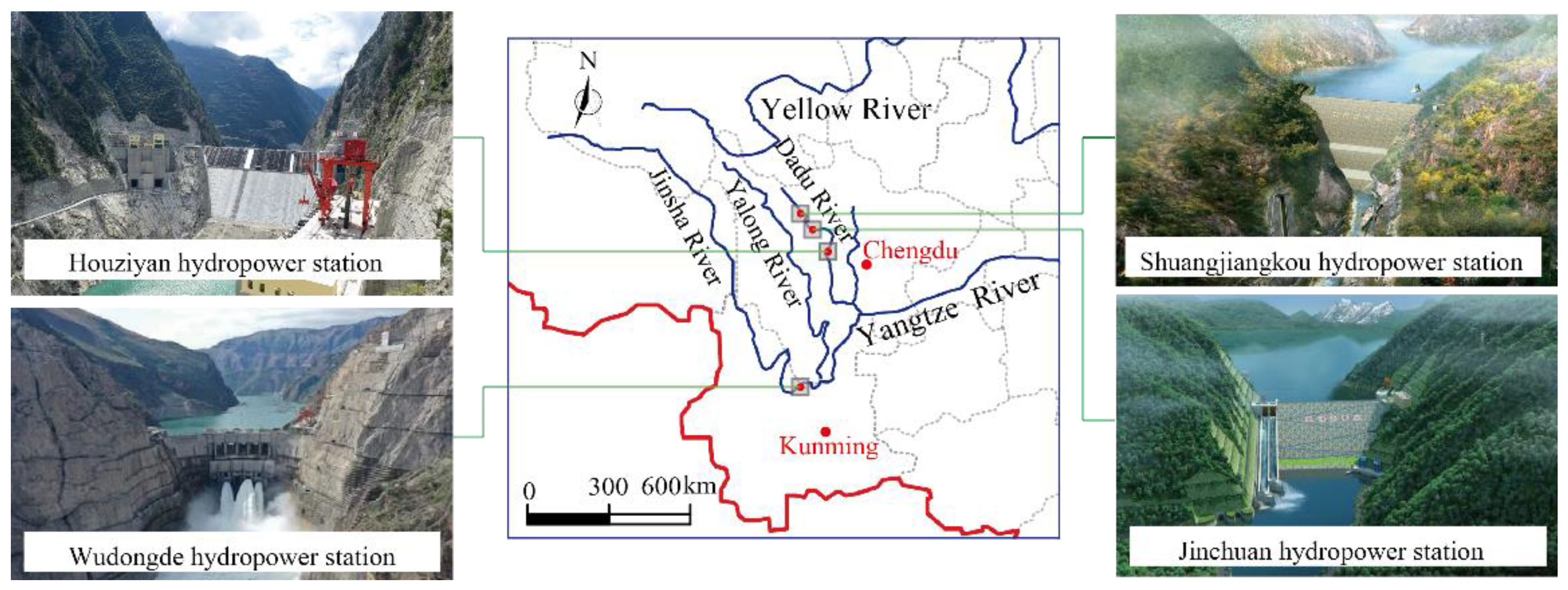


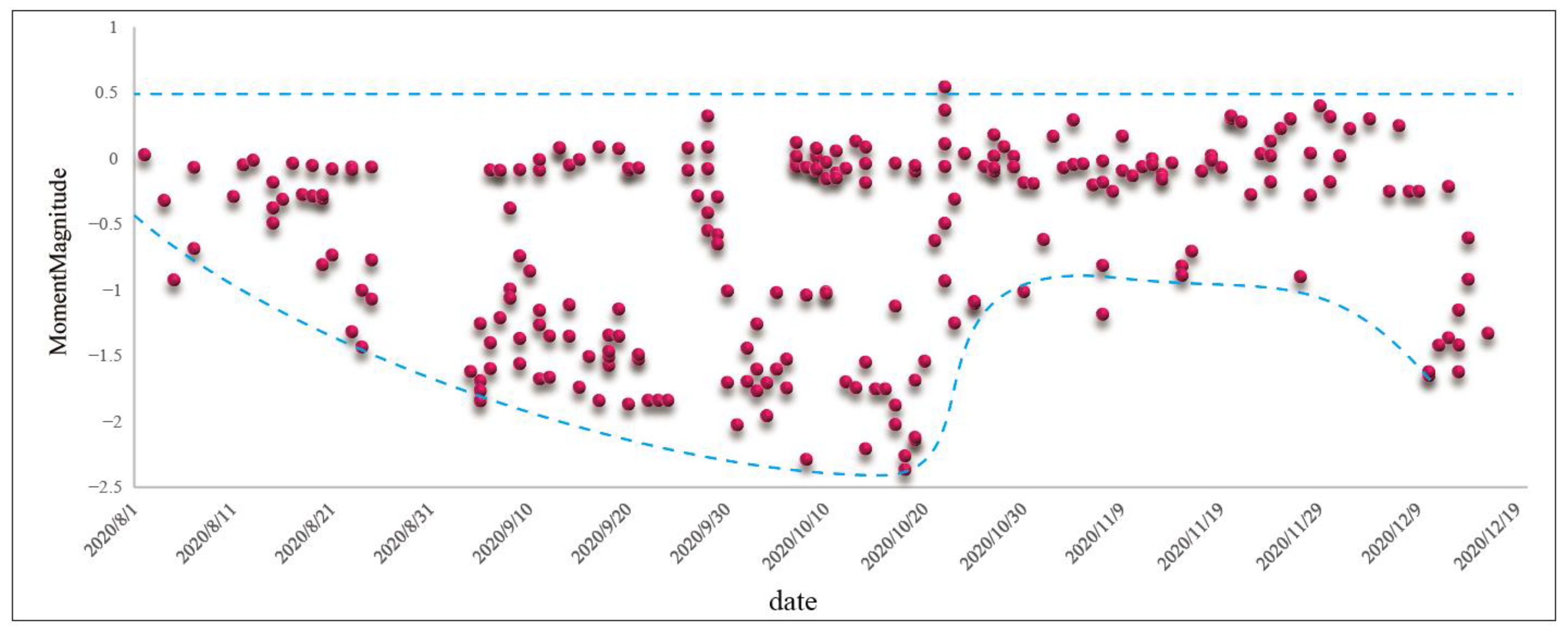


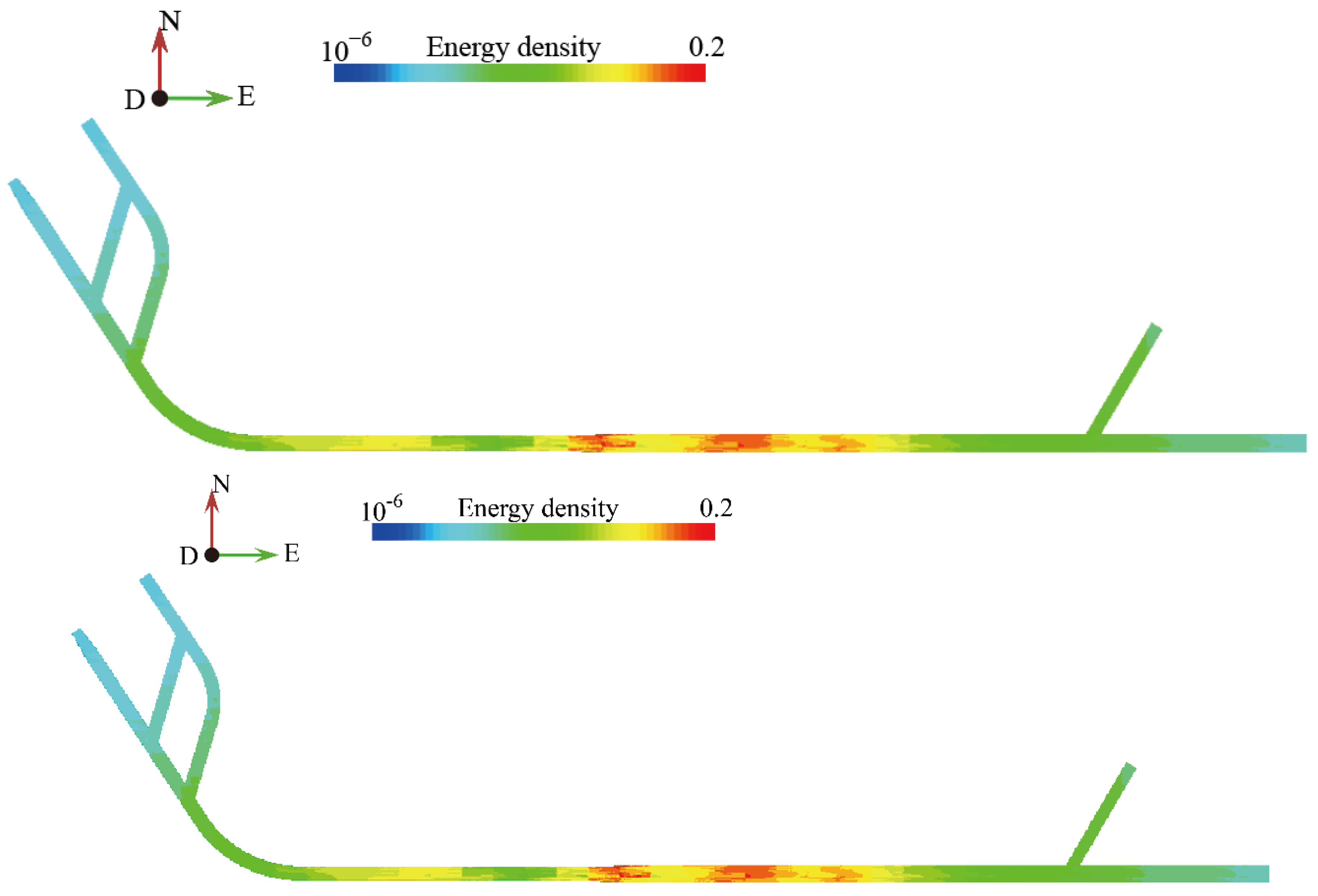
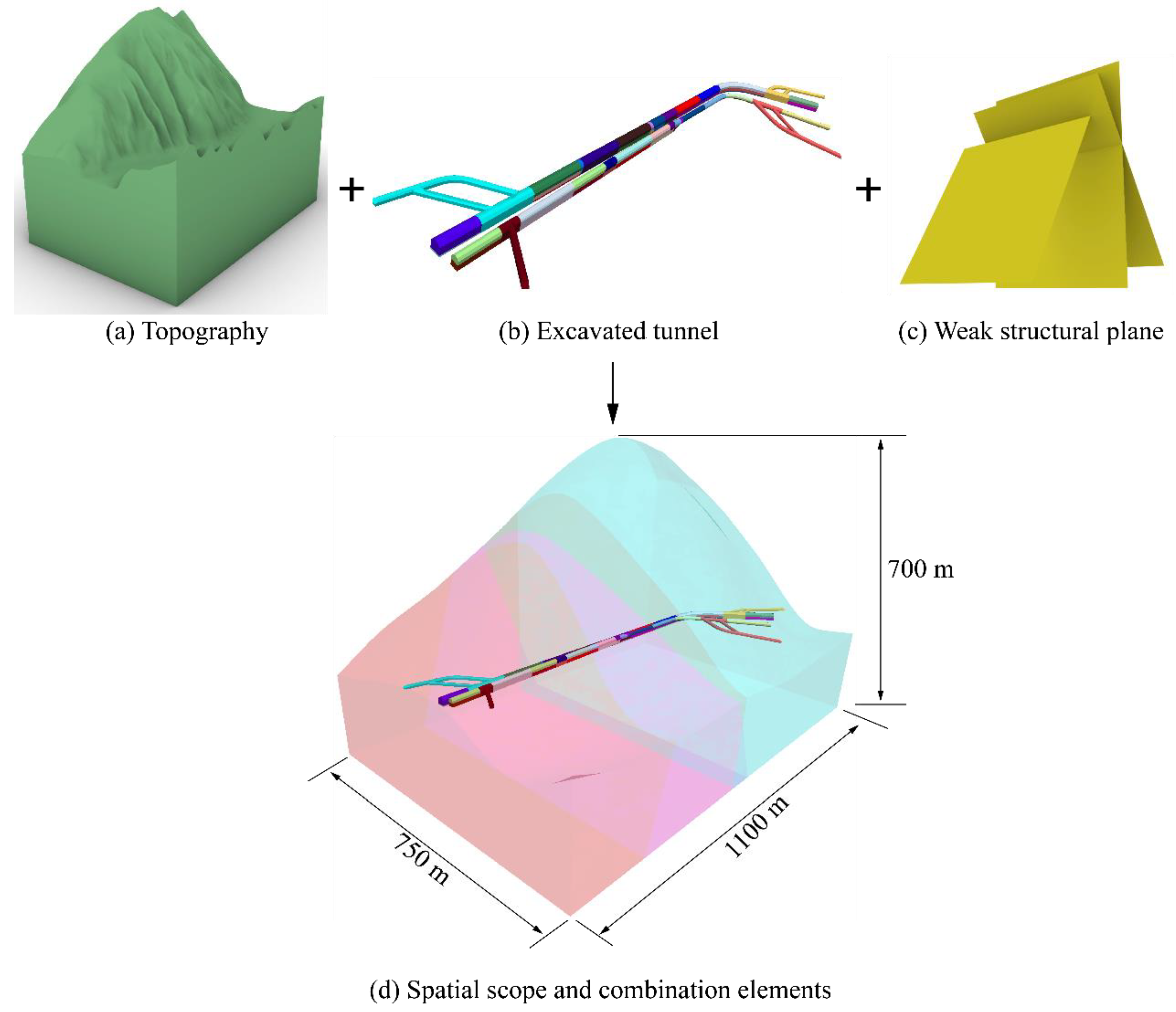
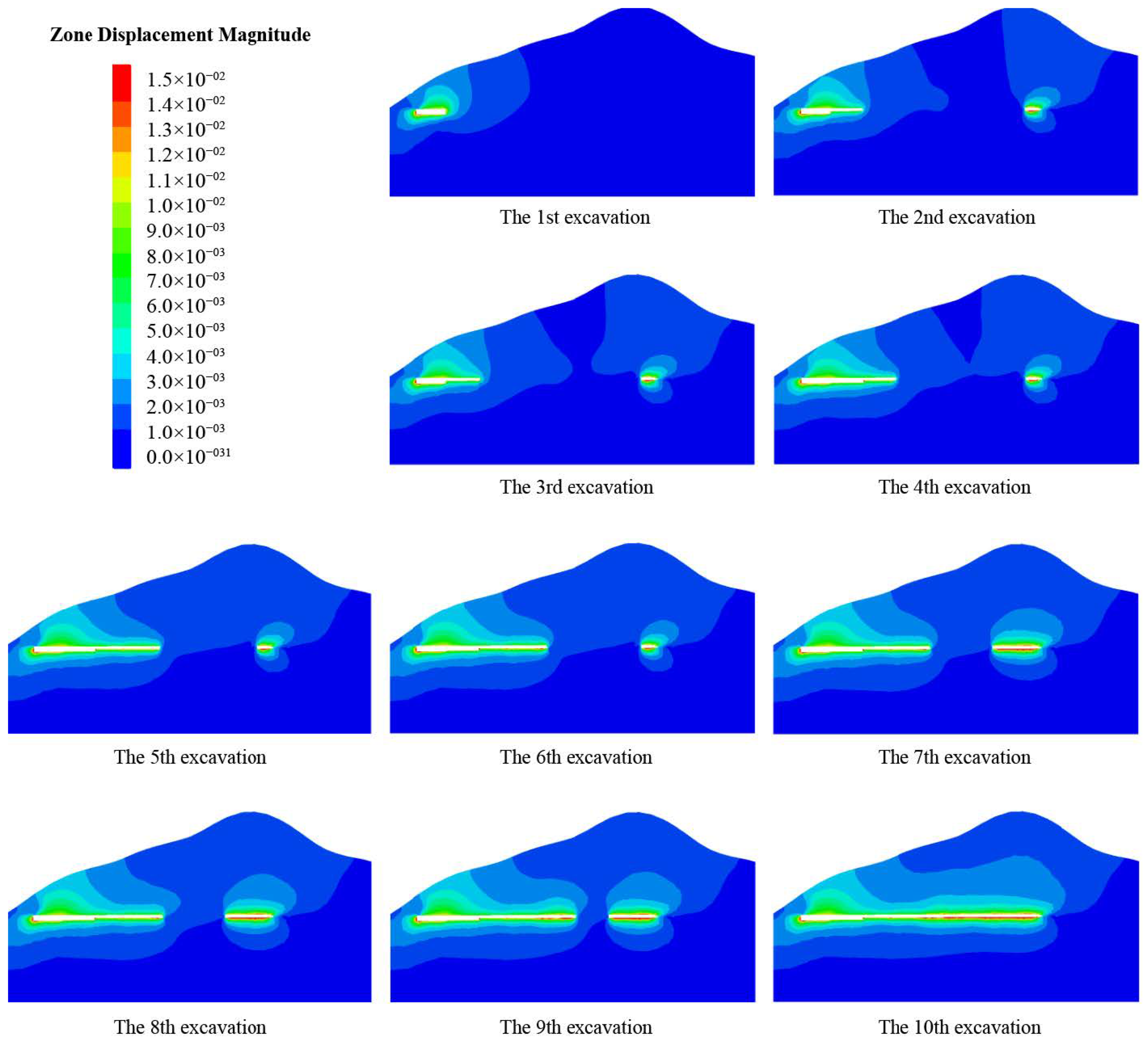

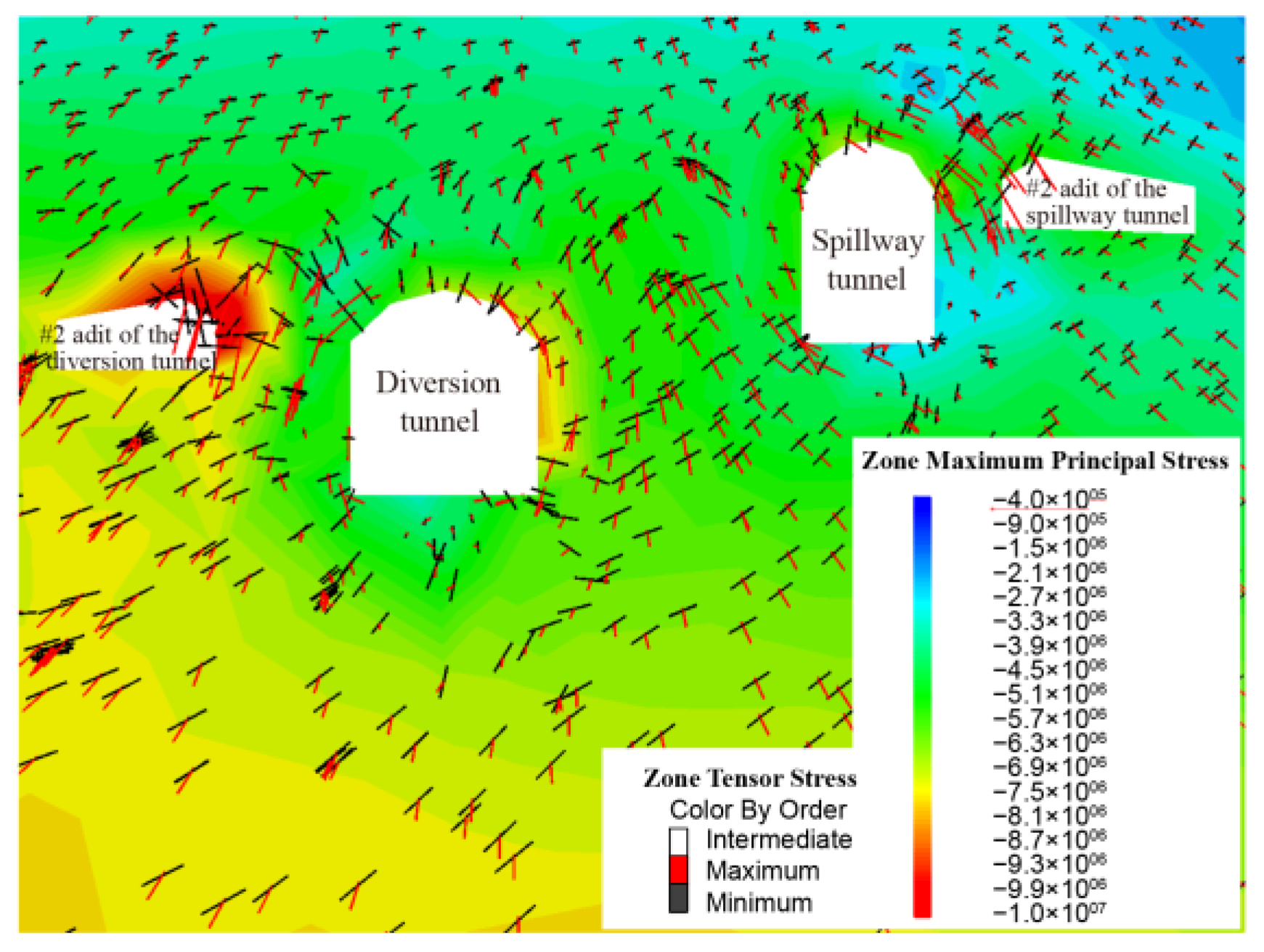




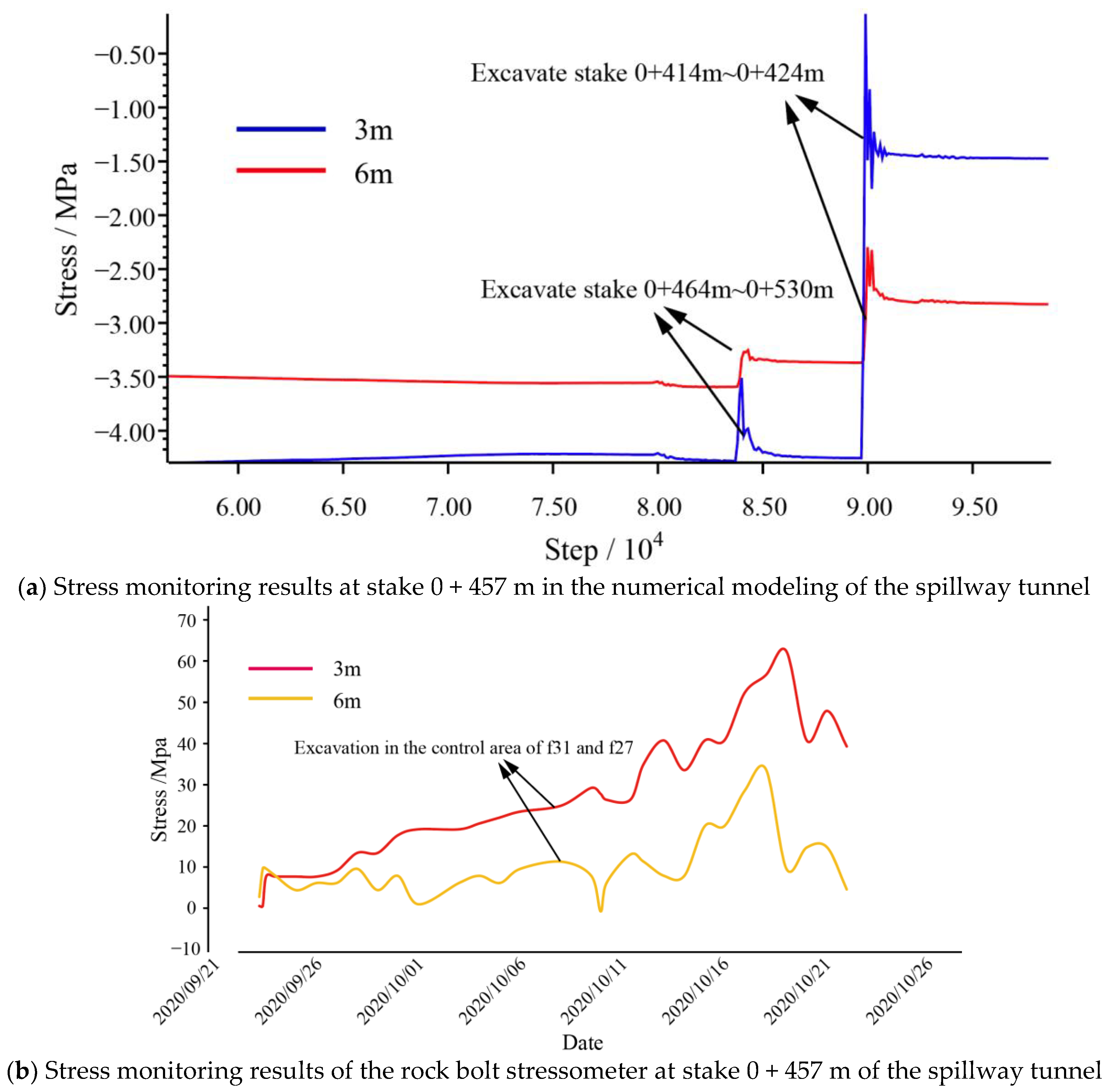


| Rock | Deformation Modulus | Elastic Modulus | Poisson’s Ratio | Rock/Rock | Allowed Bearing Capacity | |||
|---|---|---|---|---|---|---|---|---|
| Shearing Strength | Shear Strength | |||||||
| E0 (GPa) | ES (GPa) | μ | f | c (MPa) | f | c (MPa) | [R] (MPa) | |
| 4–5 | 4.5–6 | 0.30–0.35 | 0.65–0.70 | 0.30–0.40 | 0.55–0.60 | 0 | 2.0–3.0 | |
| Structural Plane Type | f′ | c′ (MPa) | |
|---|---|---|---|
| f31 | Debris with mud | 0.35–0.40 | 0.05–0.07 |
| f27 | Debris with mud | 0.35–0.40 | 0.05–0.07 |
| f54 | Debris with mud | 0.35–0.40 | 0.05–0.07 |
| Excavation Steps | Excavation Position |
|---|---|
| Step 1 excavation | Adits and adjacent main tunnels at the inlet and outlet |
| Step 2 excavation | Stakes 0 + 160 m to 0 + 240 m and 0 + 724 m to 0 + 824 m in the first layer |
| Step 3 excavation | Stakes 0 + 240 m to 0 + 340 m and 0 + 655 m to 0 + 724 m in the first layer |
| Step 4 excavation | Stakes 0 + 630 m to 0 + 655 m in the first layer |
| Step 5 excavation | Stakes 0 + 323 m to 0 + 414 m and 0 + 530 m to 0 + 630 m in the first layer, and stakes 0 + 724 m to 0 + 824 m in the second layer |
| Step 6 excavation | Stakes 0 + 464 m to 0 + 530 m in the first layer |
| Step 7 excavation | Stakes 0 + 160 m to 0 + 240 m in the second layer, and stakes 0 + 414 m to 0 + 424 m in the first layer |
| Step 8 excavation | Stakes 0 + 424 m to 0 + 464 m in the first layer |
| Step 9 excavation | \ |
| Step 10 excavation | \ |
| Excavation Steps | Excavation Position |
|---|---|
| Step 1 excavation | Adits and adjacent main tunnels at the inlet and outlet |
| Step 2 excavation | Stakes 0 + 165 m to 0 + 290 m and 0 + 790 m to 0 + 890 m in the first layer |
| Step 3 excavation | Stakes 0 + 780 m to 0 + 790 m in the first layer |
| Step 4 excavation | Stakes 0 + 690 m to 0 + 780 m in the first layer, and stakes 0 + 790 m to 0 + 890 m in the second layer |
| Step 5 excavation | Stakes 0 + 590 m to 0 + 690 m in the first layer |
| Step 6 excavation | Stakes 0 + 570 m to 0 + 590 m in the first layer |
| Step 7 excavation | Stakes 0 + 290 m to 0 + 390 m in the first layer |
| Step 8 excavation | \ |
| Step 9 excavation | Stakes 0 + 490 m to 0 + 570 m in the first layer |
| Step 10 excavation | Stakes 0 + 390 m to 0 + 490 m in the first layer |
Publisher’s Note: MDPI stays neutral with regard to jurisdictional claims in published maps and institutional affiliations. |
© 2022 by the authors. Licensee MDPI, Basel, Switzerland. This article is an open access article distributed under the terms and conditions of the Creative Commons Attribution (CC BY) license (https://creativecommons.org/licenses/by/4.0/).
Share and Cite
Zhang, Y.; Mao, H.; Li, B.; Sun, Y. Stability Analysis of Jinchuan Hydropower Station Hydraulic Tunnels during Excavation and Unloading. Appl. Sci. 2022, 12, 11660. https://doi.org/10.3390/app122211660
Zhang Y, Mao H, Li B, Sun Y. Stability Analysis of Jinchuan Hydropower Station Hydraulic Tunnels during Excavation and Unloading. Applied Sciences. 2022; 12(22):11660. https://doi.org/10.3390/app122211660
Chicago/Turabian StyleZhang, Yan, Haoyu Mao, Biao Li, and Yuepeng Sun. 2022. "Stability Analysis of Jinchuan Hydropower Station Hydraulic Tunnels during Excavation and Unloading" Applied Sciences 12, no. 22: 11660. https://doi.org/10.3390/app122211660
APA StyleZhang, Y., Mao, H., Li, B., & Sun, Y. (2022). Stability Analysis of Jinchuan Hydropower Station Hydraulic Tunnels during Excavation and Unloading. Applied Sciences, 12(22), 11660. https://doi.org/10.3390/app122211660








